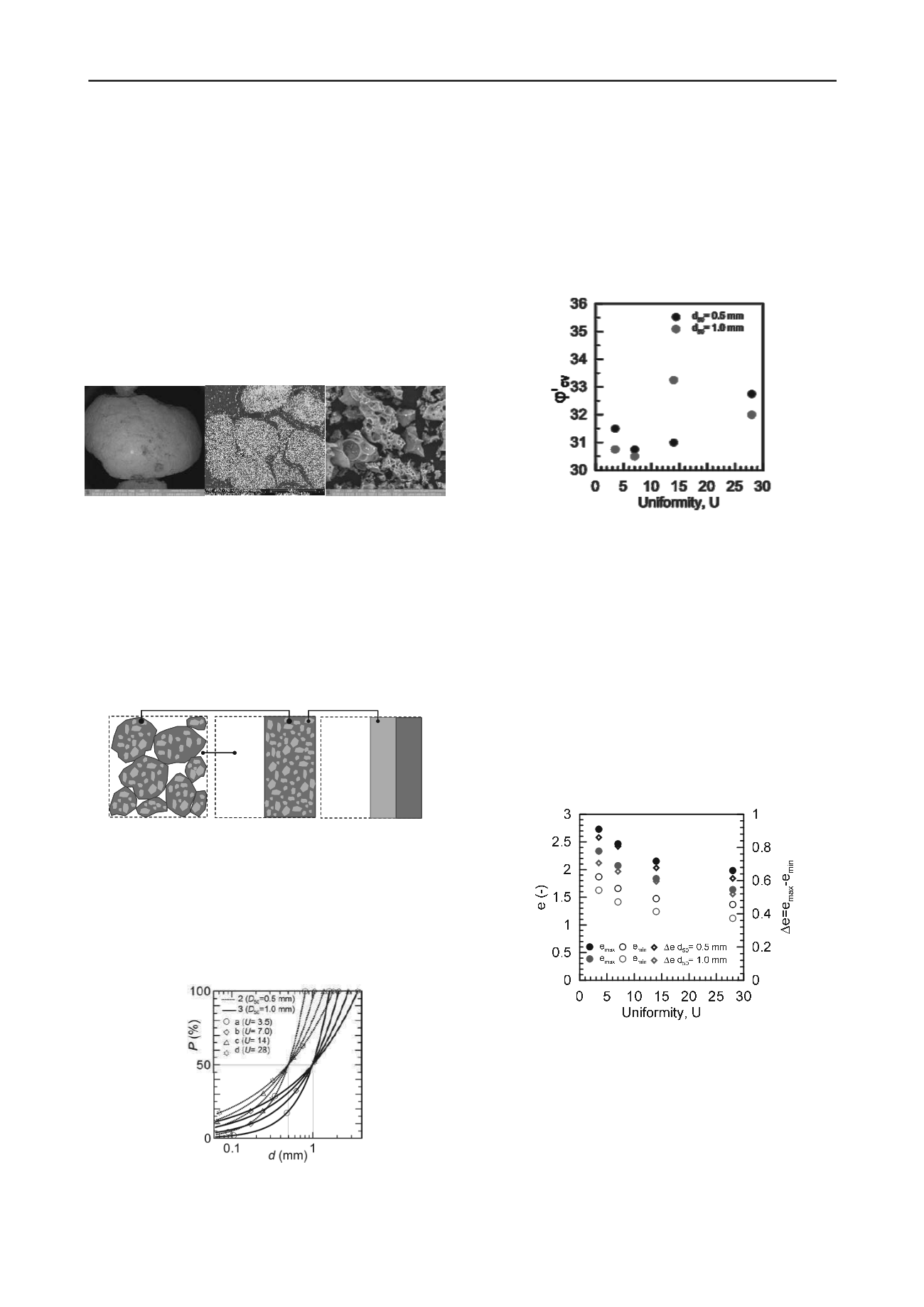
208
Proceedings of the 18
th
International Conference on Soil Mechanics and Geotechnical Engineering, Paris 2013
Proceedings of the 18
th
International Conference on Soil Mechanics and Geotechnical Engineering, Paris 2013
1. MATERIAL TESTED
A systematic experimental investigation of grain crushing for
natural materials is often difficult due to the relatively high
stress required to crush the grains and the variability and
heterogeneity of natural deposits, which makes it difficult to
obtain repeatable results. For these reasons the experimental
work was carried out on an artificial granular material.
The material used is commercially available under the
acronym LECA (Light Expanded Clay Aggregate) and is
obtained through an industrial process. The expanded clay
pellets are screened into their various fractions and made
commercially available both as intact (so-called "granular")
with a characteristic a round shape and a hard outer shell (see
Fig. 1a), or crushed, at different grain sizes (see Figs 1b-c).
(a)
(b)
(c)
Figure 1. LECA pellets whole/broken with particle diameters: (a) d=2-4
mm; (b) 0.71-1 mm; (c) d<0.063 mm (Wanninger and Zwicker, 2010).
The material has a very low apparent unit weight; this is
because the particles are characterised by the existence of a
double order of porosity: "inter-granular", i.e. voids existing
between particles, and "intra-granular", i.e. closed voids
existing within individual particles (see Fig. 2). Because of the
voids existing within the particles, their apparent unit weight,
s
,
depends on their diameter
d
as
s
(
d
) =
a
·(
d
0
/d
)
b
, with
a
= 12.64
kN/m
3
,
b
= 0.268, and
d
0
=1 mm (Casini
et al.,
2013).
INTERPARTICLE
POROSITY
LIGHTWEIGHT AGGREGATE PARTICLE
INTRAPARTICLE
VOIDS
INTRAPARTICLE POROSITY
INTERPARTICLE
VOIDS
SOLID
Figure 2. Inter-granular and intra-granular porosity (after Casini and
Viggiani, 2011).
1.1
Initial grading
The maximum particle size of the tested material was 4 mm; the
material was reconstituted to obtain grading curves with the
same mean diameter
d
50
, and different coefficients of
uniformity,
U
(= 3.5, 7, 14, 28) or the same coefficient of
uniformity,
U
and different
d
50
(= 0.5, 1 mm) (Figure 3).
Figure 3. Grain size distributions of reconstituted LECA samples.
1.2
Basic properties
The constant volume friction angle
'
cv
, and the minimum and
maximum densities corresponding to each grading were
determined before testing.
'
cv
was obtained by pouring the
material on a rough, flat surface from a given height, and
measuring the slopes of the resulting granular cone. The
experimental values of
'
cv
(Fig. 4) are in the range of 30-33°
and increase slightly with the coefficient of uniformity. There is
no obvious dependence on the mean grain size.
Figure 4. Constant volume angle of friction as function of uniformity for
crushed LECA
The maximum (e
max
) and minimum (e
min
) voids ratio were
determined using non-standard procedures so that particle
crushing would not falsify the results. In particular, e
min
was
obtained vibrating the samples with very low input energy.
The experimental values of (
e
max
-
e
min
) obtained for the
granular material (Fig. 5) at different values of
U
and
d
50
, of the
order of 0.9 ÷ 1.0, are much larger than those obtained for other
granular materials with grains that do not exhibit significant
intra-porosity, such as natural river sands, lightweight
aggregates and glass ballottini (
e
.
g
. Miura
et al.,
1997). LECA
can probably be reconstituted at very high values of voids ratio
due to the rough surface of the particles of crushed material, as
shown in Figure 1, which causes a very "open" structure with
loads carried by arching between particles, some of which are
effectively unloaded or redundant, and large inter-porosity.
Figure 5. Minimum and maximum void ratios as a function of
uniformity for crushed LECA
1.3
Microstructural features
Examples of Scanning Electron Microscopy (SEM)
micrographs of crushed LECA particles of different dimensions
are reported in Figure 6a-b. SEM micrographs of portions of
grains belonging to different fractions were manipulated using
the image editing program GIMP (Peck, 2008); the exposed
intra-granular pores were coloured progressively in black and
the contrast in the image was raised until all the pixels were
either black (pores) or white (matrix),(compare Figures 6a and


